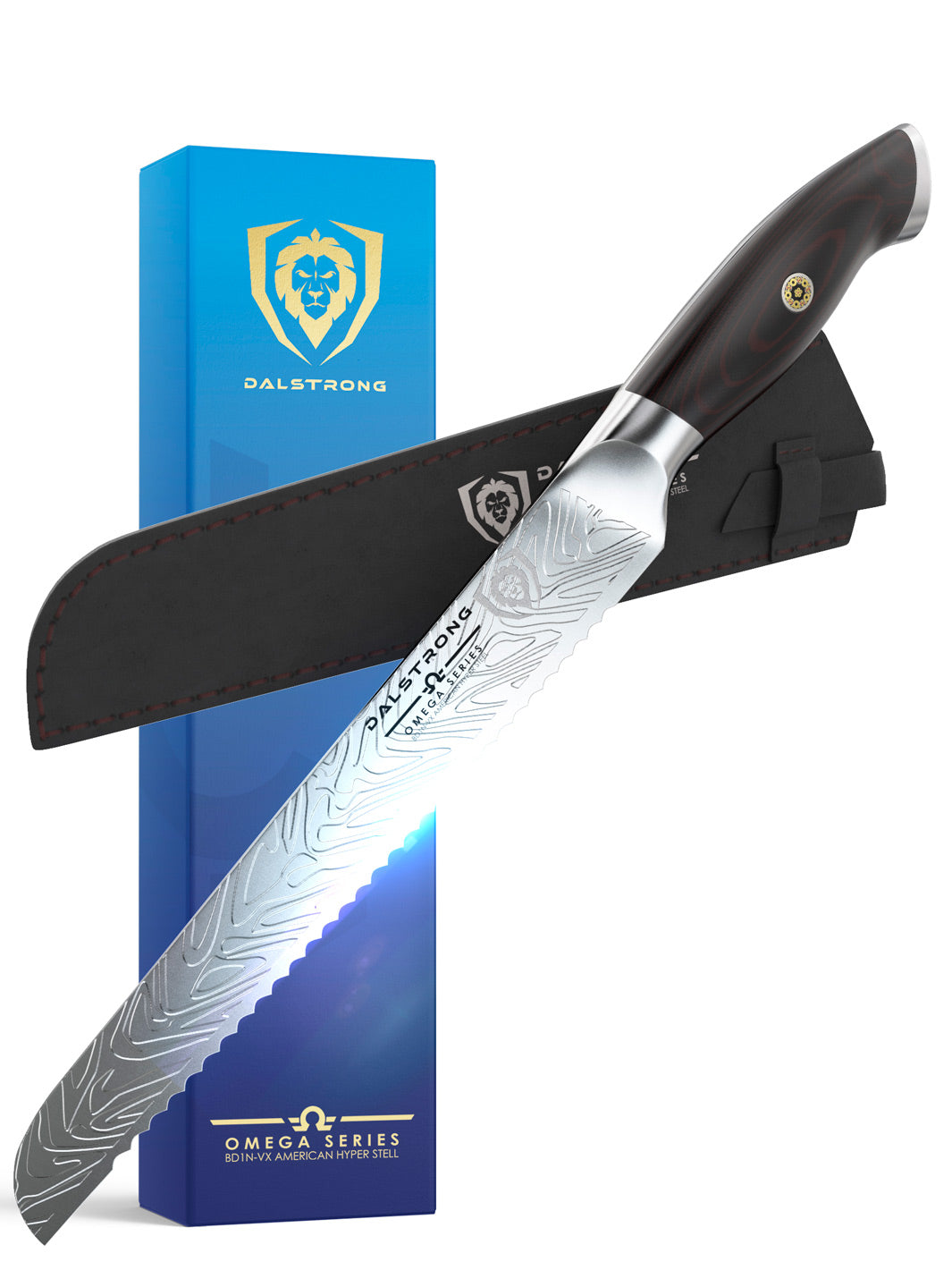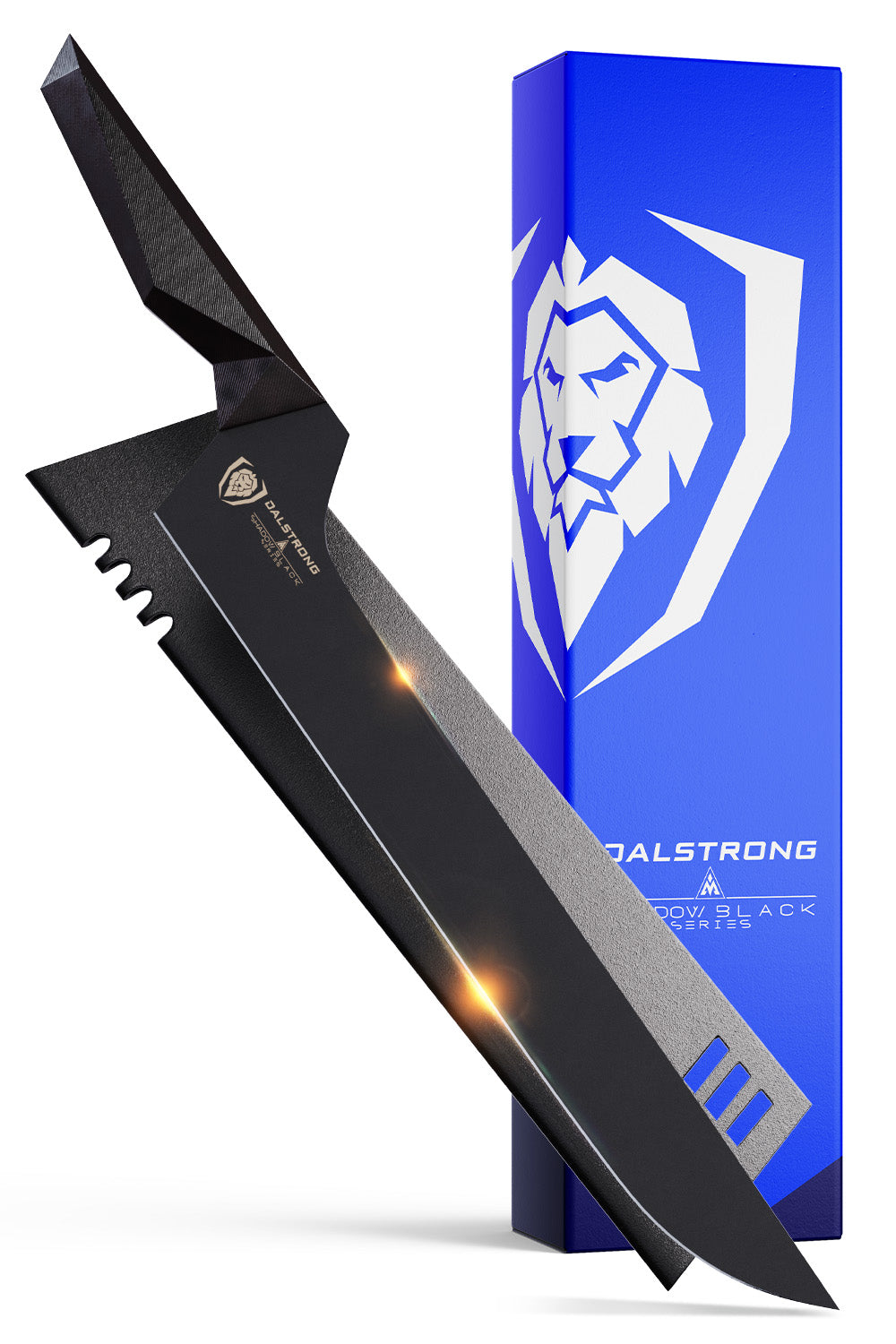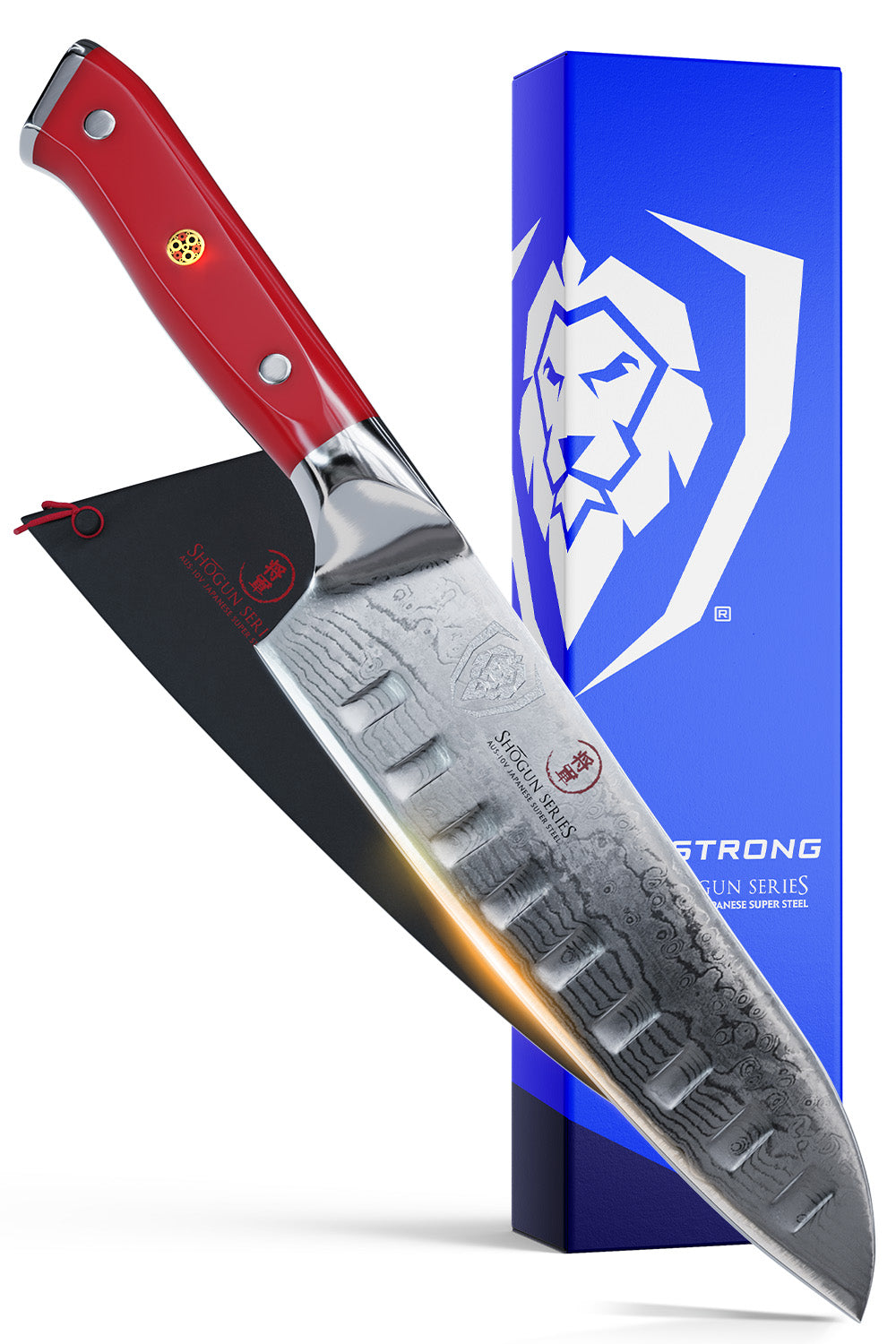Maybe because of their size or their discreet potential, paring knives are often overlooked among the essential tools in the kitchen. But once you unlock the world of possibilities provided by this tiny superhero, you’ll never go back.
It’s true that paring knives can effortlessly work on any fruit or vegetable, no matter how intricate the shape or the surface. But beyond that there is a lot of room for creativity and culinary exploration. Join us as we discover more and more paring knife uses!
1. The Main Characteristics Of A Paring Knife
 Paring Knife 3.5" Frost Fire Series NSF Certified Dalstrong
Paring Knife 3.5" Frost Fire Series NSF Certified Dalstrong
What makes a paring knife, a paring knife? Small in size but big at heart, this tool has distinguishable features that set it apart from other knives. Let’s check them out.
It’s small
Yes, the paring knife is the smallest of all kitchen knives!
It’s short
Paring knives have short, narrow blades whose lengths can measure between 2.5 and 4 inches.
It’s balanced
In a classic paring knife, the blade and the handle are similar in size, length and weight, which provides a sense of balance.
Different blade shapes
A paring knife is always compact and slender, but the blade shape can vary. These are the most common types of paring knives:
- Classic spear-tipped, they look like miniature chef's knives.
- Bird's beak, with a concave blade slightly similar to a sickle.
- Sheep's foot, they look like a mini-Santoku knife.
- Serrated, with a serrated edge.
It’s comfortable and light
A proper paring knife is designed for comfort and great control during use. Therefore it is lighter and more manageable compared to other kitchen knives.
It’s versatile
When you start using a paring knife frequently, you realize that it can be used for many common cutting tasks in the kitchen. More about this on the next point!
2. Paring Knife Uses
 Paring Knife 3.5" Shogun Series ELITE Dalstrong
Paring Knife 3.5" Shogun Series ELITE Dalstrong
We already know that a paring knife is multipurpose and incredibly handy to the point of being as essential as cutting boards and chefs knives. It’s like a mini chef knife, with the advantage of being better for precision and detailed work.
This is a list of possible uses for a paring knife. We tried to make it as extensive as possible, but there’s still a chance we fell short!
Peeling fruits and vegetables
The paring knife is ideal for removing all types of skin from fruits and vegetables, from the thick skins of apples, potatoes and carrots; to the thinner and more delicate ingredients such as ginger or turmeric.
Thin slicing
Paring knives are excellent for thinly slicing smaller ingredients like garlic, shallots, chili peppers, radishes and others.
Delicate foods and detailed tasks
Some ingredients are too small or delicate to use a chef's knife. Others require meticulous, detailed cuts that larger knives cannot perform. The paring knife is the best option in these cases.
Coring
A paring knife makes it easy to remove seeds and membranes from foods like peppers, tomatoes, kiwis or strawberries.
Removing blemishes
The paring knife allows you to remove imperfections or damaged areas on a fruit or vegetable with clean precision.
Decorations and detail work
This knife is perfect for adding a creative touch to your garnishes and dishes by cutting food into flowers, spirals or other fancy shapes. Like, if your recipe calls for skinning tomatoes, you can turn the peeled skins into a pretty tomato rose.
Citrus
With a paring knife, you can remove the thick peel from citrus fruits like oranges, lemons and limes, and get clean wedges afterward.
Pitting fruits
A paring knife can help you remove the “stone” inside certain fruits such as dates.
Preparing shellfish and deveining shrimp
When you need to open or clean shellfish, such as shrimp or prawns, a paring knife will let you to make accurate cuts and easily remove the shell or vein.
Making detailed cuts in meat
With a paring knife, you can get clean, precise and defined cuts in small meats, such as chicken, turkey or pork.
Trimming stems and leaves
Use a paring knife for other vegetable tasks, such as trimming the stems and lower leaves of Brussels sprouts, artichokes, broccoli and cauliflower.
Marking and scoring
The sharp tip of the paring knife is ideal for making fine cuts on the surface of foods, such as scoring bread dough, double-crust pies, and thick cuts of meat to help release some fat during cooking.
Subtle touches and cuts
The paring knife is designed to do the delicate, detailed work that larger knives can't do.
An infinite number of small tasks
Paring knives come in handy for simple and quick cuts in everyday activities. You will discover most of them by yourself! Some uses that I have found and personally love include slicing hard-boiled eggs, unmolding a cake or cutting clean portions of butter.
3. Tips For Maintaining And Using A Paring Knife
 Paring Knife 3.75" Shadow Black Series NSF Certified Dalstrong
Paring Knife 3.75" Shadow Black Series NSF Certified Dalstrong
These are some tips for giving your paring the knife the care it deserves.
Proper use
The best way of taking care of your paring knife is safe handling and proper use. Use the knife only for the purposes it was designed: small cutting tasks and moderate-sized foods like fruits and vegetables.
Don’t use it for hard foods or bones (surely there are knives for that) and, evidently, don’t use it for things or activities that aren’t related to cooking.
Proper cleaning
As with every knife, we don’t recommend using the dishwasher. Washing by hand, immediately after every use, is always the best option.
Keep it simple with warm water (not hot) and a small amount of mild dish soap. Apply with a sponge or soft cloth. Especially with the blade, never use abrasive materials or tools since it can be damaged quickly.
Moreover, you should dry thoroughly after washing to prevent moisture from building on the blade (which can later lead to rust).
Proper storage
How you store the paring knife is also crucial for its performance and maintenance. Some paring knives come with their own sheath (see recommendations below) which is the best option if it’s going to be stored in a drawer or carried from one kitchen to another. Magnetic strips and knife blocks are also great options for in-site knife storage.
The important thing is that the knife is clean, dry and separated from other knives and utensils.
Proper sharpening
Sharpening is essential for paring knives and knives in general. It’s also unavoidable: you’re going to have to sharpen any blade at some point.
You can do it yourself or take it to a professional. If you do it yourself, you can choose from several methods including sharpening stones, honing rods or even electric sharpeners. But beware, you’ll need to work on certain skills to keep the sharpening job efficient and safe.
4. Top Dalstrong Paring Knives
1. 3-Piece Paring Knife Set - Gladiator Series
This paring knife set is designed to cover almost every possible meal prep task, from trimming to garnishing. The set includes a standard, multipurpose straight edge paring knife, a bird’s beak knife for peeling and working small ingredients; and a serrated paring knife for special foods like tomatoes, cheese and cured meats.
PROS:
- If one paring knife is super versatile, imagine having three! These knives are suitable for working with a wide range of fruits, vegetables, bread, and small meats.
- Practical and comfortable to use during extended periods of cooking.
- As with all Gladiator knives, the blades are made of high-carbon German steel, known for its durability, sharpness, and resistance.
- Easy to clean: making your life easier in every way.
- They come with perfect fitting Dalstrong sheaths.
CONS:
- The set doesn’t come with its own storage, so you have to buy one separately.
- It’s possible that you don’t really want the whole set and would be equally satisfied with just one.
2. Paring Knife 3.5" - Shogun Series ELITE
This best seller in the Dalstrong Shogun series provides exceptional strength and performance with its high quality Japanese steel and scalpel-like sharpness. Along with the exclusive blade pattern, its most remarkable quality, it will excel at so much more than just cutting fruits and vegetables.
PROS:
- Eye-catching Tsunami Rose blade pattern exclusive to the Shogun series.
- Perfect weight distribution with "zero balance" for total control and more precision.
- Damascus coating for superior stain resistance and durability.
- Traditional Japanese style D-grip that fits perfectly in the palm of the hand for perfect maneuverability.
- Full Tang: a stronger, tougher knife forged from a single piece.
- Triple riveted handle, meticulously constructed to last a lifetime.
CONS:
- The price is a bit steep and may exceed some budgets. If this is your case, Dalstrong has other options you can look at such as the Paring Knife 3.5" from the Vanquish Series.
- If you're someone who prefers to cut herbs with the swinging motion of a chef's knife, you might want to look at the Chef's Knife 8" Shogun Series ELITE.
3. Serrated Paring Knife 3.75" - Gladiator Series
The serrated edge is especially handy for crusty foods, tough-skinned fruits and vegetables, as well dried meats. Another use case for the serrations, as opposed to straight-edge paring knives, is intricate cutting and pattern scoring. So, if that’s your jam, you might want to look into this Gladiator!
PROS:
- The serrated blade will dominate certain ingredients where a straight edge might fail, like crusty or thick-skinned fruits and veggies.
- Black G10 Garolite handle from Spain, laminated for strength and water/stain resistance.
- The Gladiator design is a crowd-pleaser: it is aesthetically beautiful in any criteria.
- It feels balanced and comfortable in your hand.
- The included PerfectFit sheath keeps the knife safe.
CONS:
- While it is the best option for serrated cutting, other tasks and foods will still require a straight edge paring knife.
- As I said, the Gladiator aesthetic is a crowd-pleaser, but some cooks may be looking for something else, like a rustic or minimalistic approach.
4. Bird's Beak Paring Knife Peeler 3" - Crusader Series
This is a one-of-a-kind peeling knife with a stunning design. Its curved bird beak blade is sharp and versatile, ideal for peeling, grooving and preparing decorative garnishes with precision. The Crusader series combines functionality and modern minimalism.
PROS:
- Stunning one-piece stainless steel construction with seamless blade-to-handle transition.
- Ergonomic handle design.
- The top groove along the blade balances the knife and at the same time, it decreases friction and food sticking.
- Satin-finished steel with high chromium content for long-lasting shine.
- Additional protection: it comes with an elegant magnetic sheath.
CONS:
- This paring knife is designed for specific tasks. Some home cooks prefer the classic paring knife shape for their everyday common culinary tasks.
- The design is avant-garde and unconventional. For more conservative individuals, check this Bird's Beak Paring Knife from the Gladiator Series.
5. Paring Knife 4" - Valhalla Series
This paring knife has a truly epic look: short but intense, like the life of the Vikings. Also majestic, like the gods they worshiped. As the bold design suggests, this knife will triumph when it comes to peeling, deveining, removing seeds, and more.
PROS:
- The resin handle with stabilized wood has been exceptionally crafted, adding a special touch to the knives.
- Each handle is unique: every blend of wood and resin is different. no two knives look the same.
- Surgical precision thanks to the straight, super sharp edge.
- 5 layers of high quality Japanese steel for superior performance.
- With a Rockwell hardness of over 60, this knife can handle even the toughest tasks without losing its edge.
CONS:
- Once you fall in love with the Valhalla series (and you will) you may have to juggle your budget to purchase the complete series.
5. Frequently Asked Questions About Paring Knives
Can you utilize a paring knife to cut meat?
The paring knife is used to peel fruits and vegetables, devein shrimp and assist the chef knife with smaller tasks. But you can also use a paring knife for small cuts of meat.
How can I segment citrus fruits with a paring knife?
The paring knife is ideal for segmenting citrus fruits. After peeling, hold the fruit with your nondominant hand and the knife with the other. Then cut between each membrane of the fruit to separate the segments.















